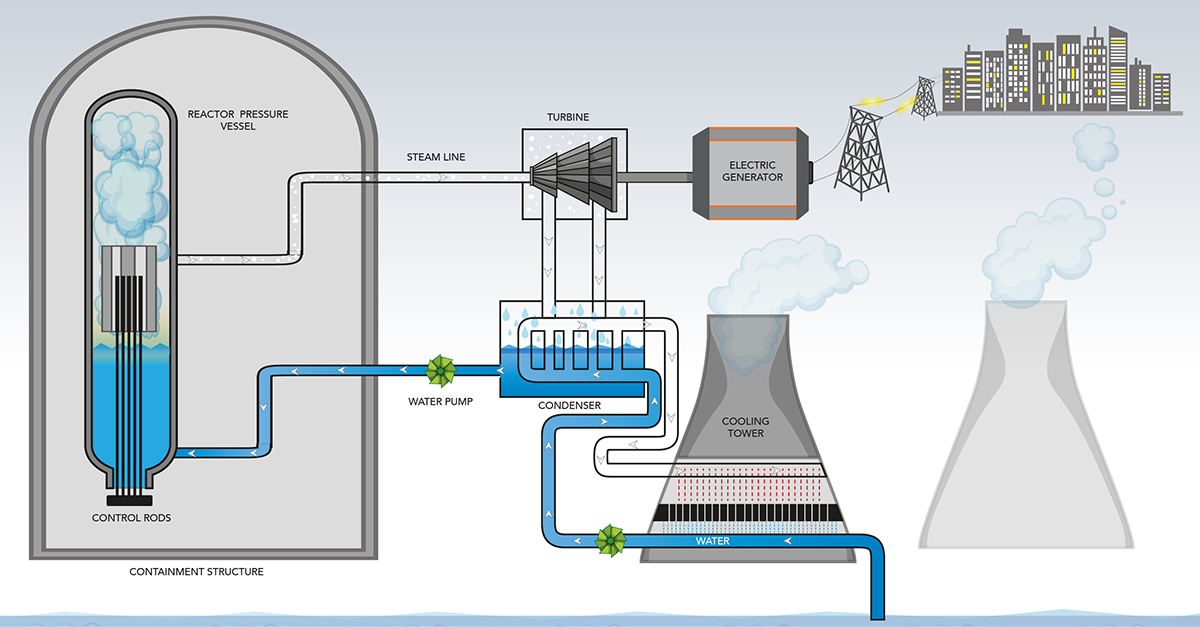Why Nuclear Energy is Safer Than You Think
The rising population growth and economic development in developing countries are accelerating the demand for energy by 50% in the next 30 years, especially electrical power. Fossil fuels account for 84% of the world’s energy consumption, and in 2018, 89% of global CO2 emissions resulted from fossil fuel burning.
Climate change is recognized as the “most systemic threat to humankind” by the United Nations, warning that exceeding 1.5°C will have catastrophic consequences. At the current rate of fossil fuel consumption, the global average temperature is predicted to increase by 0.3°C every decade. Many nations are now aware of fossil fuels’ negative environmental impacts and are seeking alternative energy production methods. Therefore, the energy transition from fossil fuels to nuclear power can create a more sustainable future.

How Nuclear Power Works
Nuclear power is a renewable energy source generated in a nuclear reactor of a power plant that obtains heat energy from fission. It relies on the fissioning of uranium nuclei and a controlled chain reaction. As fissile radioisotopes can undergo fission even with slower neutrons, U-235 is used instead of the fertile radioisotope U-238.
U-235 fissions into two atoms, two or three additional neutrons, and kinetic energy while it absorbs a neutron. These neutrons are absorbed by other U-235 atoms, which release more neutrons and create a fission chain reaction. The fuel element, U-235, is surrounded by a moderator, such as light water, graphite, or heavy water, to reduce the high-velocity neutrons’ speed. This moderation increases the fission chance by allowing the neutrons to be readily absorbed by fissile nuclei.

Water in the nuclear reactor is warmed up by the heat generated from the nuclear fission of U-235 atoms. To monitor the fission rate in the uranium nuclei, control rods made of neutron-absorbing material, such as boron, regulate the heat that the fission produces. The control rods absorb neutrons to stop the chain reaction and are lifted so that sufficient neutrons can sustain a chain reaction. Then, the heat is pumped inside a steam generator, which converts water into steam. The steam spins a turbine to operate an electric generator and produce electricity. Finally, the smoke is recycled, condensed into water in the cooling tower, and reused to generate more electricity.

Advantages of Nuclear Power
Nuclear power plants have environmental advantages over any other renewable energy source. Fissioning uranium atoms replaces fossil fuels’ burning, so nuclear reactors do not emit greenhouse gases. Although greenhouse gases produced in the mining and refining process of uranium ore are equivalent to 3 tonnes of CO2 per gigawatt-hour of electricity, it is considerably less than coal, oil, and natural gas. As a result, nuclear power has saved 490 million tonnes of carbon emissions a year compared to generating the same electricity from coal.
According to NASA and Columbia University, more than 1.8 million deaths have been avoided between 1971 and 2009. However, uranium-fueled nuclear reactors are not a long-term solution to carbon emissions as uranium is a limited natural resource and not a fully renewable energy resource. Fortunately, new nuclear reactor technologies, such as thorium, are being tested because they are more abundant than uranium.
Disadvantages of Nuclear Power
However, the environmental benefits of nuclear energy are challenged by the economic disadvantages of nuclear power plants. Four factors determine the cost of a nuclear power plant: the capital costs of construction, decommissioning and waste disposal costs, fuel costs, and operation and maintenance costs.
Since the Three Mile Island accident and the Chernobyl disaster, nuclear power plants have had more rigorous safety requirements, increasing construction costs. From 2002 to 2008, building a nuclear power plant grew from around USD 3 billion to USD 9 billion. Even though nuclear power plants’ fuel and operation costs are relatively low, the initial budget is often insufficient as the government must allocate extra funds for radioactive waste management. Otherwise, it will defeat the purpose of reducing global greenhouse gas emissions and creating a more sustainable future. As nuclear power plants have been valued more like a business by large corporations, their high cost has made it challenging for atomic power to compete with fossil fuels and other renewable energy sources that are less environmentally friendly.
Nuclear Power In A Nutshell
The world must realize that nuclear power is a long-term investment that will significantly affect climate change’s future, particularly when the global average temperature rise of 1.5°C becomes irreversible between 2027 and 2042 if no action is to be taken. Therefore, the energy transition from fossil fuels to nuclear power is necessary, and the world will need to act quickly before the environmental impact of fossil fuels leaves a permanent scar on Earth.

